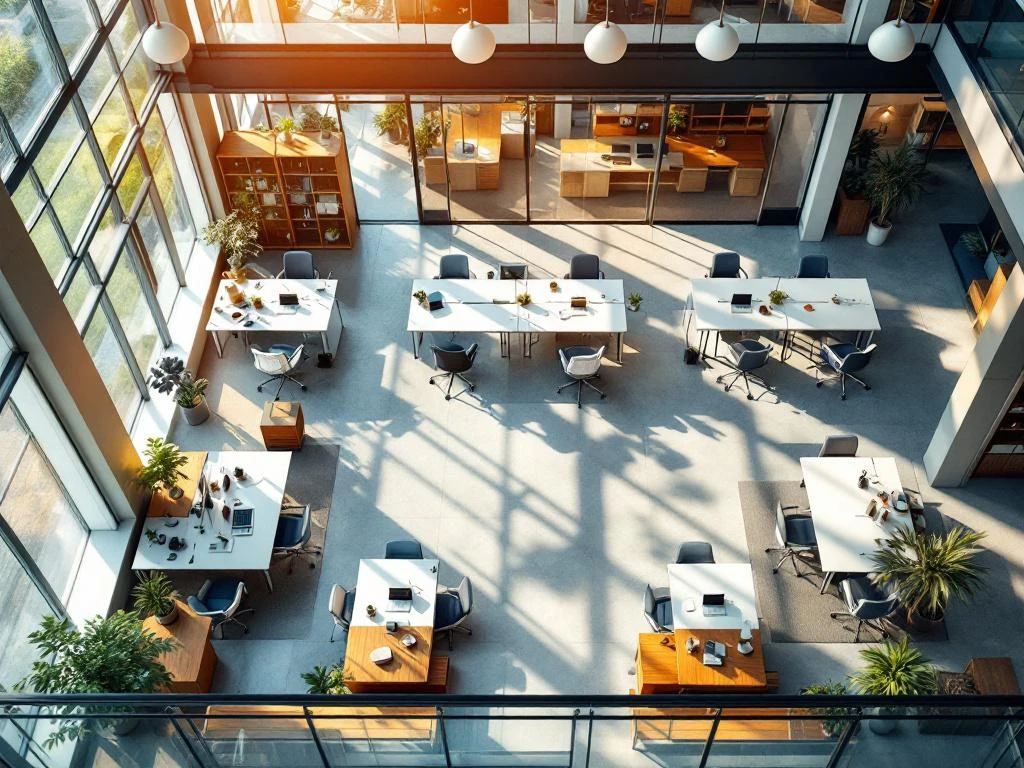For a good working environment, you have on average 10 to 15 square meters office space per employee required. This includes workspace and some of the common areas. The exact amount depends on your type of business, working style and whether you opt for flex-working. In the Netherlands, according to the NEN 1824 standard, there is a minimum of 7m² per workplace, but for a comfortable and productive working environment, more space is recommended.
What is the standard office space per employee?
The standard office space per employee is between 10 and 15 square meters for traditional offices. This is the generally accepted guideline that many companies use when planning their office layout. The Dutch NEN 1824 standard prescribes a minimum of 7m² per workplace, but this is really the bare minimum for a safe working environment.
In practice, you see that most organizations opt for more spacious setups. A standard workplace with desk, chair and some space to move around quickly requires 6 to 8m². Add to that the space needed for aisles, closet space and some of the common facilities, and you end up with that 10 to 15m² per person.
Standards may differ for different positions within a company. An employee who receives many visitors or holds confidential conversations needs more space than someone who works primarily at the computer. Managers and board members are often assigned 15 to 20sqm, while for administrative positions, 8 to 10sqm is sufficient.
How do you calculate the required office space?
Calculating your total office space is fairly simple: multiply the number of employees by the square footage per workspace and add the common areas. A practical formula is: (number of employees × m² per workplace) + 40% for common areas = total office area.
Suppose you have 20 employees and you calculate with 12m² per person. Then you need 20 × 12 = 240m² of workstations. For the common areas, you add 40%, so 96m². In total, you then need 336m² of office space. This calculation gives you a good basis to start with.
Don't forget to consider future growth as well. If you expect to grow to 30 employees within two years, it's smart to take that into account now. You should also include specific needs such as a large reception area, additional meeting rooms or a showroom in your calculation. For companies that Considering renting office space, it is important to properly identify these factors in advance.
What factors determine how much space you need?
The amount of office space you need depends on several factors. The type of work plays a big role: creative teams that collaborate a lot need different spaces than employees who do concentrated individual work. The degree of privacy needed for work also determines how much space you should reserve.
Your corporate culture also affects space requirements. An organization that values personal contact and spontaneous meetings will want more common spaces than a company where everyone works mostly independently. The percentage of employees who work flexibly is also important. If half of your team regularly works from home, you can get by with fewer workspaces.
Technology plays an increasing role in how much space you need. Companies that work completely digitally need less filing space. Teams that video call a lot, on the other hand, need quiet rooms or phone booths. So the nature of your business largely determines what spaces you need and how much square footage that requires.
What is the difference between open offices and private offices in terms of space?
Open offices are much more efficient in terms of space usage than private offices. In an open office environment, you need an average of 6 to 10m² per person, while cubicle offices quickly require 10 to 15m² per employee. This difference is because in open offices you don't have to consider partitions and the associated walking space.
The advantage of open offices is that you can fit more employees in the same space. A 100-square-meter space can accommodate about 10 to 12 people in an open setting, while you can only fit 6 to 8 private offices in that same space. On the other hand, open offices require more investment in good acoustics and partitions to reduce noise pollution.
Many companies today choose to use a combo office: a mix of open workspaces and some private spaces. This gives flexibility for different working styles and activities. For such a combination, calculate an average of 8 to 12m² per employee, depending on the ratio of open to closed spaces.
How much space do you need for flexible workstations?
With flexible workstations, you work with a different calculation than with fixed workstations. The rule of thumb is that you need 0.7 to 0.8 workplace per employee when working with hot-desking or activity-based working. This means that for 10 employees, about 7 to 8 flexible workstations are sufficient.
This savings on workstations is because never are all employees in the office at the same time. People work at home, are with clients or are in meetings. By making smart use of available space and offering different types of workstations, you can optimize occupancy. Think of standing workstations for short work, lounge corners for informal consultations and concentration areas for deep thinking.
Space savings with flex work can be as much as 30% of your total office space. A company with 50 employees that would normally need 600m² can make do with 420m² with a good flex-working concept. You can invest these savings in better facilities or use them to cut costs, especially interesting if you rent office space in an expensive location such as when your office space for rent Amsterdam considering.
What common areas should you include in your calculation?
In addition to workstations, you need several common areas for a well-functioning office. The most important are meeting rooms, a pantry or canteen, toilets, checkroom and a reception area. You also need to reserve space for technical facilities such as a server room or storage area. All these spaces together usually make up 30 to 40% of your total office space.
The size of these rooms depends on the number of employees and the nature of your business. For toilets, calculate at least one toilet for every 15 employees. A pantry needs a minimum of 15 to 20m² for basic facilities. Meeting rooms range from 10m² for a small meeting room to 30m² or more for large meetings.
It's smart to create multifunctional spaces. A large meeting room can also serve as a presentation room or training venue. The lunch room can be used outside lunchtime for informal meetings. By thinking intelligently about the use of spaces throughout the day, you can be more efficient with the square footage available.
| Type of space | Guideline surface area | Number of persons |
|---|---|---|
| Small meeting room | 10-15 m² | 4-6 people |
| Large meeting room | 25-40 m² | 10-16 people |
| Pantry/kitchen | 15-25 m² | Up to 30 employees |
| Toilet group | 15-20 m² | Per 15 employees |
| Reception area | 20-30 m² | Depending on visit |
How can you use office space more efficiently?
Being efficient with office space starts with a smart layout. Look critically at how intensively different areas are used. That conference room that is only occupied twice a week? Maybe you could better divide it up or make it multifunctional. Vertical storage is an underrated way to save space: use the height of your office with wall cabinets and shelving.
Digitization offers enormous opportunities for space savings. By digitizing archives, you can replace entire rooms full of binders with a small server. Flexible furniture solutions such as folding tables and movable partitions make it possible to quickly adapt rooms to different needs.
Also consider the flow in your office. Place functions that work together a lot close together. Make sure the coffee corner is centrally located so people naturally run into each other. By cleverly planning walking routes, you avoid the need for extra corridor space. Measure how spaces are used regularly and adjust your layout accordingly.
What are the benefits of having the right amount of office space?
The right amount of office space has a direct effect on your team's productivity. Employees who have enough space to work comfortably perform better and are less likely to be distracted. A good balance of open spaces for collaboration and quiet areas for concentration creates a pleasant working atmosphere where everyone can function optimally.
The right space also has a positive effect on health. Adequate space for movement, good ventilation and natural light contribute to less absenteeism. Employees who feel comfortable in their work environment are more loyal and stay with your company longer. This saves you recruitment costs and ensures continuity in your team.
From a cost perspective, the right amount of space is also important. Too much space means unnecessary costs; too little space leads to dissatisfaction and reduced productivity. A professional image to clients and partners is also a benefit of sufficient and well-appointed office space. It exudes success and professionalism when visitors step into a spacious and well cared for office.
Key insights on office space per employee
The general guideline of 10 to 15m² per employee remains a good starting point for most offices. This amount provides sufficient space for comfortable working and the necessary amenities. It is important to adapt this guideline to your specific situation: your working style, corporate culture and the degree of flex working determine your exact space requirements.
Flexibility is the key word for modern offices. By being smart about workplace concepts such as hot-desking and activity-based working, you can save significantly on space. Don't forget that common areas are just as important as workspaces, these usually make up 30 to 40% of your total area.
Whether you're a startup looking for its first office or an established company looking to optimize, the right amount of office space contributes to the success of your organization. At Co-Office, we understand that every organization has unique needs. We offer flexible office solutions that grow with your business, whether you have 5 or 50 employees. Want to discover what options are available for your situation? Then take contact with us for a free consultation on the perfect workspace for your team.

